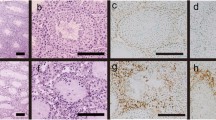Abstract
Background
Rat dicarboxylate transporter (SDCT1), expressed in renal tubular epithelial cells, plays a key role in regulating blood and urinary citrate level by reabsorbing citrate from the lumen. Antibodies against this transporter are very important for investigating its expression and function. With the cytokine gene as a molecular adjuvant, genetic immunization-based antibody production offers several advantages compared with current methods. This study aimed, by genetic immunization, to produce a high-specificity antibody against SDCT1.
Methods
We fused a high-antigenicity fragment of SDCT1 to the plasmid pBQAP-TT containing T-cell epitopes and flanking regions from tetanus toxin. Mice were immunized by gene-gun immunization with recombinant plasmid and two other adjuvant plasmids that express granulocyte/macrophage colony-stimulating factor and FMS-like tyrosine kinase 3 ligand, respectively. The titer of the antibody was detected by enzyme-linked immunosorbent assay (ELISA). Specificity of the antibody was identified with SDCT1 native protein in rat kidney by Western blot analysis and immunohistochemistry, and with SDCT1 protein expressed on Xenopus oocytes plasma membranes by immunofluorescence.
Results
ELISA measurements showed that the antibody titer was 1:32,000. The native protein of SDCT1 in rat kidney can be recognized by this antibody with Western blot analysis and immunohistochemistry. Immunofluorescence showed that this antibody also recognized SDCT1 protein targeted to Xenopus oocytes plasma membranes into which SDCT1 full-length cRNA was injected.
Conclusion
Generation of a high-specificity immunoglobulin G antibody against SDCT1 by genetic immunization has provided an important tool for the study of citrate transport.





Similar content being viewed by others
References
Pajor AM (2006) Molecular properties of the SLC13 family of dicarboxylate and sulfate transporters. Pflugers Arch 451:597–605
Chen XZ, Shayakul C, Berger UV et al (1998) Characterization of a rat Na+-dicarboxylate cotransporter. J Biol Chem 273:20972–20981
Chen X, Tsukaguchi H, Chen XZ et al (1999) Molecular and functional analysis of SDCT2, a novel rat sodium-dependent dicarboxylate transporter. J Clin Invest 103:1159–1168
Pak CY (1994) Citrate and renal calculi: an update. Miner Electrolyte Metab 20:371–377
Jenkins AD, Dousa TP, Smith LH (1985) Transport of citrate across renal brush border membrane: effects of dietary acid and alkali loading. Am J Physiol 249:F590–F595
Wu D, Chen XM, Ye YZ et al (2000) Expression of citrate transporter mRNA in the kidneys of rats with metabolic acidosis (Chinese). Sheng Li Xue Bao 52:55–58
Elbashir MI, Nilson BH, Akesson P et al (1990) Antibody response in immunized rabbits measured with bacterial immunoglobulin-binding proteins. J Immunol Methods 135:171–179
Pizza M, Scarlato V, Masignani V et al (2000) Identification of vaccine candidates against serogroup B meningococcus by whole-genome sequencing. Science 287:1816–1820
Wang W, Guo G, Tang J et al (2000) Stimulatory activity of anti-peptide antibodies against the second extracellular loop of human M2 muscarinic receptors. Chin Med J 113:867–871
Field CM, Oegema K, Zheng Y et al (1998) Purification of cytoskeletal proteins using peptide antibodies. Methods Enzymol 298:525–541
Babiuk LA, van Drunen Littel-van den Hurk S, Babiuk SL (1999) Immunization of animals: from DNA to the dinner plate. Vet Immunol Immunopathol 72:189–202
Tang DC, DeVit M, Johnston SA (1992) Genetic immunization is a simple method for eliciting an immune response. Nature 356:152–154
Ghochikyan A, Vasilevko V, Petrushina I et al (2003) Generation and characterization of the humoral immune response to DNA immunization with a chimeric beta-amyloid-interleukin-4 minigene. Eur J Immunol 33:3232–3241
Trinchieri G (1998) Immunobiology of interleukin-12. Immunol Res 17:269–278
Barouch DH, Letvin NL, Seder RA (2004) The role of cytokine DNAs as vaccine adjuvants for optimizing cellular immune responses. Immunol Rev 202:266–274
Baca-Estrada ME, Ewen C, Mahony D et al (2002) The haemopoietic growth factor, Flt3L, alters the immune response induced by transcutaneous immunization. Immunology 107:69–76
Chambers RS, Johnston SA (2003) High-level generation of polyclonal antibodies by genetic immunization. Nat Biotechnol 21:1088–1092
Zheng X, Xie L, Qin J et al (2008) Effects of wortmannin on phosphorylation of PDK1, GSK3-beta, PTEN and expression of Skp2 mRNA after ischemia/reperfusion injury in the mouse kidney. Int Urol Nephrol 40:185–192
Sun W, Hu Y, Gong J et al (2005) Identification of beta-lactamase inhibitory peptide using yeast two-hybrid system. Biochemistry (Mosc) 70:753–760
Eslamifar A, Hamkar R, Ramezani A et al (2007) Hepatitis G virus exposure in dialysis patients. Int Urol Nephrol 39:1257–1263
Hosoyamada M, Ichida K, Enomoto A et al (2004) Function and localization of urate transporter 1 in mouse kidney. J Am Soc Nephrol 15:261–268
Zhao J, Tramontano A, Makker SP (2007) Albumin-stimulated TGFbeta-1 in renal tubular cells is associated with activation of MAP kinase. Int Urol Nephrol 39:1265–1271
Kaygusuz G, Tulunay O, Baltaci S et al (2007) Microvessel density and regulators of angiogenesis in malignant and nonmalignant prostate tissue. Int Urol Nephrol 39:841–850
Enomoto A, Kimura H, Chairoungdua A et al (2002) Molecular identification of a renal urate anion exchanger that regulates blood urate levels. Nature 417:447–452
Wang Z, Yuan Z, Matsumoto M et al (2005) Immune responses with DNA vaccines encoded different gene fragments of severe acute respiratory syndrome coronavirus in BALB/c mice. Biochem Biophys Res Commun 327:130–135
Zheng LY, Mou L, Lin S et al (2005) Enhancing DNA vaccine potency against hantavirus by co-administration of interleukin-12 expression vector as a genetic adjuvant. Chin Med J 118:313–319
Acknowledgments
We are grateful to Dr. Ross Chambers for providing pBQAP-TT, pCMVi-GMCSF, and pCMVi-FIT3L plasmids, Dr. Xing-Zhen Chen for providing pBluescript vector containing SDCT1 full-length cDNA, and Dr. Xuesong Liu for providing anti-mouse Ig-subclass-specific HRP-conjugated secondary antibodies. This work was partly supported by a grant (XJGX0736L04) from Xijing Hospital, Xi’an, China.
Author information
Authors and Affiliations
Corresponding author
Additional information
G. Xu and A. Liu contributed equally to this work.
Rights and permissions
About this article
Cite this article
Xu, G., Liu, A. & Liu, X. Use of genetic immunization to generate a high-level antibody against rat dicarboxylate transporter. Int Urol Nephrol 41, 171–178 (2009). https://doi.org/10.1007/s11255-008-9432-x
Received:
Accepted:
Published:
Issue Date:
DOI: https://doi.org/10.1007/s11255-008-9432-x




